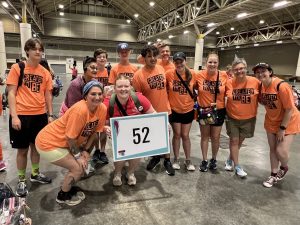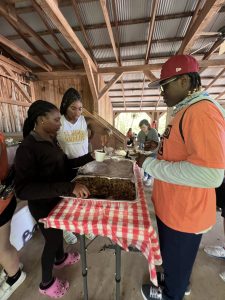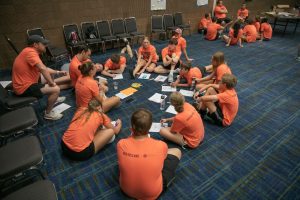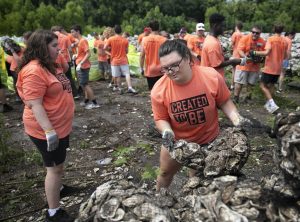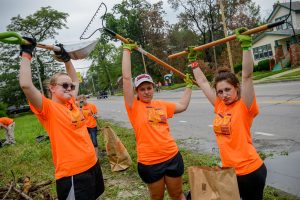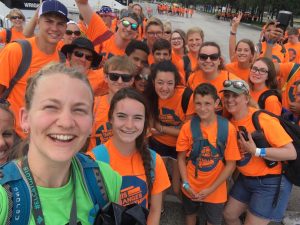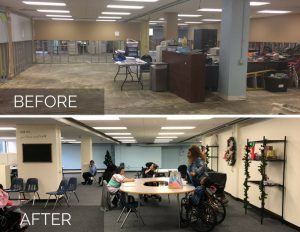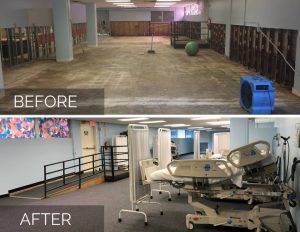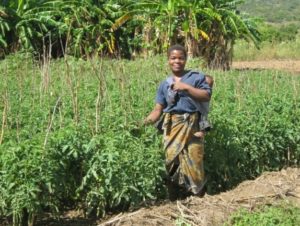Thursday, July 18 – Created to Be Free
Today, over 5k Gathering participants in bright orange shirts launched into the city for “Accompaniment Day,” a day dedicated to walking alongside and supporting the people of New Orleans. Participants engaged with community leaders who are making significant impacts locally and globally. Each project was crafted by local leaders to deepen their missions, highlighting the importance of partnership and continued impact.
Accompaniment involves more than physical tasks; it includes learning about culture, food, and justice-centered work. As we engage in God’s mission, building relationships is essential to proclaiming the Gospel. Participants cleaned parks, painted playgrounds, cleared storm drains, and beautified the New Orleans Women and Children’s Shelter.
Dr. Kristen Contos Krueger, Director of Accompaniment, shared, “I want them to learn that the problems they see in New Orleans are not exclusive to New Orleans. Racism, social justice, and environmental justice are issues everywhere. The experiences here are lessons to take home.”
Some participants attended Color of Grace’s workshop, encouraging youth to be instruments of God’s love and justice. Pastor Aaron from the Southern Ohio Synod expressed his hope for the future. “These young people have the love of Christ and the ability to change the world.” Ian from the Virginia Synod shared his commitment to using his voice for good, saying, “I am created to be bold in a better way to reciprocate God’s love.”
Other students participated on-site with various groups including ELCA Witness in Society. Amy Reumann, ELCA Senior Director for Witness in Society, led discussions on local concerns and the role of public policy in breaking down or reinforcing walls. She inspired students to become advocates, saying, “We can bring the stories of our communities to impact the laws that are passed.”
Some participants worked with the Coalition to Restore Coastal Louisiana (CRCL) by supporting CRCL’s Oyster Shell Recycling Program, which collects shells from restaurants and public drop-off sites to build oyster reefs and shoreline habitats. Additional participants engaged with Let’s Be Bigger, a non-profit focused on building relationships for a bigger future. Founder Malik Baloney emphasized the importance of mutual service – aiming to create a bridge between Gathering students and St. James Parish residents. Students learned about the area’s history, engaged with local high school youth, and experienced authentic Louisiana cuisine, including home-cooked jambalaya. Through this cultural learning experience, participants became part of something bigger, gaining new perspectives and understanding a culture different from their own. This experience marked a crucial first step in breaking down barriers and building bridges, inspiring them to foster unity and empathy.
Today, miraculously after Accompaniment participants returned from their sites, New Orleans experienced torrential rain and flash floods. Yet, with God’s grace, the rain stopped just in time for participants to head to the Smoothie King Center for the third night of Mass Gathering. The rain did not dampen the spirit of this Lutheran parade as participants entered the arena filled with energy and excitement for the evening.
E-L-C-A 🎉 E-L-C-A 🎉 E-L-C-A 🎉 echoed through the arena as emcees hyped the crowd, who responded with enthusiasm. The arena was alive with the jazzy beats of the “Two Horn Jazz Duo” featuring Ryan Thibodaux on trumpet and Michael Hotstream on saxophone. The House Band and dancers got everyone moving to “Praise the Lord, oh my Soul,” and DJ CJ kept the crowd grooving, even dancing to the Macarena.
We also had the privilege to hear from phenomenal speakers tonight.
Drew Tucker, executive director of HopeWood Outdoors, spoke about his struggle with an eating disorder and the freedom found in being true to oneself. He encouraged students, saying, “You were created to be free from the burden of being someone else because you were created to be free, fully and wholly yourself.”
Sianna, a young adult speaker, reminded everyone that nothing can separate us from God’s love. Quoting Romans, she emphasized, “Nothing, and I mean nothing, can separate us from the love of God. Our past mistakes, losses, confusion, or even our insecurities. Nothing can separate us from the love of God.” She encouraged everyone to embrace their true selves, saying, “Be free, I mean it… BE FREE!”
Austin Channing Brown, author of “I’m Still Here,” delivered a powerful message to students of color, emphasizing their inherent worth. She declared, “People of color, you are not the work. Racial justice is the work.” On a night centered around the theme “Created to Be Free,” her words resonated deeply, highlighting the call to honor human dignity and strive for systemic change. Channing Brown urged us to reframe our thinking, stating, “People who are homeless are not the work. Housing is the work. People who are hungry are not the work. Food insecurity is the work. Those in toxic neighborhoods are not the work. Environmental racism is the work.”
Austin was a tough act to follow, but incoming freshman Jada took the stage tonight with such poise and beautifully delivered a piece that she wrote herself. This 13-year-old was strong and eloquent as her spoken word performance about Jesus’ commitment to justice, calling everyone to “fight for justice with love and care.”
The night ended with Keats Miles-Wallace, who spoke about discovering their true self in college and the freedom of being loved by God as they are. Keats inspired everyone, saying, “God created you to be free. Free to be your truest selves, free to be proud of who you are, free to be weird and different and unique.”
As you go out into this world, remember Keats’ words, “You have the power to help make a world where everyone gets to shine in whatever colors, patterns, or shapes God designed for them. You can make a world where everyone experiences the way God delights in them.”
You are created to be FREE!


